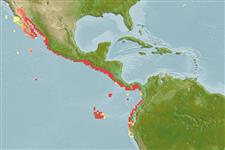分类 / Names
俗名 | 同种异名 | Catalog of Fishes(属, 种) | ITIS | CoL | WoRMS | Cloffa
Teleostei >
Carangiformes (Jacks)
鱸形目 (Jacks) >
Carangidae (Jacks and pompanos) > Caranginae
Etymology: Caranx: French, carangue, the name of a Caribbean fish; 1836 (Ref. 45335).
More on author: Günther.
Environment: milieu / climate zone / depth range / distribution range
生态学
海洋; 半咸淡水; 海洋洄游的 (Ref. 51243); 深度上下限 1 - 350 m (Ref. 9283). 亞熱帶的; 33°N - 7°S, 119°W - 76°W
Eastern Pacific: San Diego, California, USA to Peru, including the Gulf of California and the Galapagos Islands. Probably the same species as Caranx hippos in the Atlantic.
東太平洋: 聖地牙哥,美國加州到祕魯, 包括加州灣與加拉巴哥群島。 在大西洋的可能同種 馬鰺〔Caranx hippos〕 。
大小 / 重量 / 年龄
Maturity: Lm ? range ? - ? cm
Max length : 101 cm FL 雄鱼/尚未辨别雌雄; (Ref. 40637); common length : 60.0 cm TL 雄鱼/尚未辨别雌雄; (Ref. 9283); 最大体重: 17.7 kg (Ref. 40637); 最大年龄: 15 年 (Ref. 98594)
Body deep, elongated and slightly compressed; eye with an adipose eyelid; posterior edge of lower jaw behind posterior edge of eye; chest mostly scaleless, just a small patch in front of pectoral fins; 35 to 42 strong scutes; back of body blue to blue black; belly white, silvery, or yellow; pectoral fins and operculum each with a black spot (Ref. 55763).
身体纵深的﹐瘦长的与些微扁长形; 眼睛有一个脂眼睑; 眼的下颌在后后缘的后缘; 胸大部份无鳞片, 只是在胸鳍之前的一个小块; 35 到 42个强的鳞甲; 身体蓝色到蓝色的黑色的背面; 腹部白色的﹐银色的﹐或黄色的; 胸鳍与鳃盖每个具有一个黑色的斑点.(参考文献 55763)
Adults occur in oceanic and coastal waters, commonly found in shallow water, with larger individuals up to 350 m depth (Ref. 9283). Also found in brackish water and occasionally ascend rivers (Ref. 9283). They form medium-sized to big schools, but large adults may be solitary (Ref. 9283). They feed mainly on fishes, but also takes shrimps and other invertebrates (Ref. 9283). Often makes a grunting sound when captured (Ref. 9283). Juveniles are often found in river estuaries (Ref. 9283). Marketed fresh, frozen, smoked and salted or dried; also utilized as fishmeal and a source of oil (Ref. 9283).
出现于大洋性的与沿岸水域, 普遍发现于浅水区, 有较大的个体向上到 350 公尺深.(参考文献 9283) 也发现于半淡咸水而且偶然地溯河。 (参考文献 9283) 形成中等大小的到大的鱼群,但是大的成鱼可能是独居性。 (参考文献 9283) 稚鱼时常被发现于河口。 (参考文献 9283) 主要吃鱼, 也捕食虾与其他的无脊椎动物.(参考文献 9283) 时常制造一哼声音当捕获.(参考文献 9283) 在市场上销售生鲜地了, 冷冻, 烟熏了与盐腌或乾燥的; 也利用了制成鱼粉与一个油的来源。 (参考文献 9283)
Life cycle and mating behavior
Maturities | 繁殖 | Spawnings | Egg(s) | Fecundities | 仔鱼
東太平洋: 聖地牙哥,美國加州到祕魯, 包括加州灣與加拉巴哥群島。 在大西洋的可能同種 馬鰺〔Caranx hippos〕 。
Eschmeyer, W.N., E.S. Herald and H. Hammann, 1983. A field guide to Pacific coast fishes of North America. Boston (MA, USA): Houghton Mifflin Company. xii+336 p. (Ref. 2850)
人类利用
渔业: 商业性; 游钓鱼种: 是的
工具
特别资料
下载 XML
网络资源
Estimates based on models
Preferred temperature (Ref.
123201): 12.9 - 21.7, mean 15.7 °C (based on 68 cells).
Phylogenetic diversity index (Ref.
82804): PD
50 = 0.5000 [Uniqueness, from 0.5 = low to 2.0 = high].
Bayesian length-weight: a=0.01622 (0.01033 - 0.02547), b=2.95 (2.82 - 3.08), in cm total length, based on LWR estimates for this species & Genus-body shape (Ref.
93245).
营养阶层 (Ref.
69278): 3.9 ±0.61 se; based on food items.
Generation time: 5.4 ( na - na) years. Estimated as median ln(3)/K based on 2
growth studies.
回复力 (Ref.
120179): 中等的, 族群倍增时间最少 1.4 - 4.4年 (Preliminary K or Fecundity.).
Fishing Vulnerability (Ref.
59153): Moderate to high vulnerability (47 of 100).
Nutrients (Ref.
124155): Calcium = 28.6 [11.4, 60.7] mg/100g; Iron = 0.665 [0.328, 1.382] mg/100g; Protein = 20.4 [18.1, 22.9] %; Omega3 = 0.388 [0.210, 0.722] g/100g; Selenium = 35.6 [15.3, 84.4] μg/100g; VitaminA = 7.38 [2.23, 21.63] μg/100g; Zinc = 0.416 [0.252, 0.668] mg/100g (wet weight);
